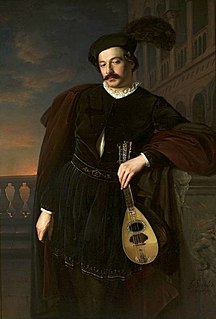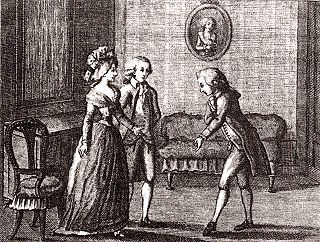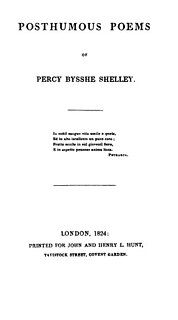
Lady Caroline Lamb was an Anglo-Irish aristocrat and novelist, best known for Glenarvon, a Gothic novel. In 1812 she had an affair with Lord Byron, whom she described as "mad, bad, and dangerous to know". Her husband was The Hon. William Lamb, who after her death became British prime minister.
Ottava rima is a rhyming stanza form of Italian origin. Originally used for long poems on heroic themes, it later came to be popular in the writing of mock-heroic works. Its earliest known use is in the writings of Giovanni Boccaccio.

Don Juan, also known as Don Giovanni (Italian), is a legendary, fictional Spanish libertine who devotes his life to seducing women. Famous versions of the story include a 17th-century play, El burlador de Sevilla y convidado de piedra by Tirso de Molina, a 1787 opera, Don Giovanni, with music by Mozart and a libretto by Lorenzo da Ponte, and a satirical, epic poem, Don Juan, by Lord Byron.

Marguerite Gardiner, Countess of Blessington, was an Irish novelist, journalist, and literary hostess. She became acquainted with Lord Byron in Genoa and wrote a book about her conversations with him.

The Byronic hero is a variant of the Romantic hero as a type of character, named after the English Romantic poet Lord Byron. Both Byron's own persona as well as characters from his writings are considered to provide defining features to the character type.
William Stewart Rose (1775–1843) was a British poet, translator and Member of Parliament, who held Government offices. From a Tory background, he was well-connected in the political and literary world, and made a mark by his championing of Italian poets and a burlesque style of verse based on their influence as satirists.

In English literature, Don Juan (1819–1824), by Lord Byron, is a satirical, epic poem that portrays Don Juan not as a womaniser, but as a man easily seduced by women. As genre literature, Don Juan is an epic poem, written in ottava rima and presented in sixteen cantos. Lord Byron derived the character, but not the story, from the Spanish legend of Don Juan. Upon initial publication in 1819, cantos I and II were criticised as immoral, because the author Byron too freely ridiculed the social subjects, the persons, and the personages of his time. At his death in 1824, Lord Byron had written sixteen of seventeen cantos, whilst canto XVII went unfinished.

In 18th- and 19th-century Italy, the cicisbeo or cavalier servente was the man who was the professed gallant or lover of a woman married to someone else. With the knowledge and consent of the husband, the cicisbeo attended his mistress at public entertainments, to church and other occasions, and had privileged access to this woman. The arrangement is comparable to the Spanish cortejo or estrecho and, to a lesser degree, to the French petit-maître. The exact etymology of the word is unknown; some evidence suggests it originally meant "in a whisper". Other accounts suggest it is an inversion of bel cece, which means "beautiful chick (pea)". According to OED, the first recorded usage of the term in English was found in a letter by Lady Mary Wortley Montagu dated 1718. The term appears in Italian in Giovanni Maria Muti's Quaresimale Del Padre Maestro Fra Giovanni Maria Muti De Predicatori of 1708.

Elizabeth Anne, Lady William Russell was the wife of Lord George Russell and a well known socialite.

Mazeppa is a narrative poem written by the English Romantic poet Lord Byron in 1819. It is based on a popular legend about the early life of Ivan Mazepa (1639–1709), who later became Hetman of Ukraine. Byron's poem was immediately translated into French, where it inspired a series of works in various art forms. The cultural legacy of Mazeppa was revitalised with the independence of Ukraine in 1991.
Nationality words link to articles with information on the nation's poetry or literature.
Nationality words link to articles with information on the nation's poetry or literature.

Teresa, Contessa Guiccioli (1800–1873) was the married lover of Lord Byron while he was living in Ravenna and writing the first five cantos of Don Juan. She wrote the biographical account Lord Byron's Life in Italy.

George Gordon Byron, 6th Baron Byron,, simply known as Lord Byron, was an English poet and peer. One of the leading figures of the Romantic movement, Byron is regarded as one of the greatest English poets. He remains widely read and influential. Among his best-known works are the lengthy narrative poems Don Juan and Childe Harold's Pilgrimage; many of his shorter lyrics in Hebrew Melodies also became popular.

The Story of Rimini was a poem composed by Leigh Hunt, published in 1816. The work was based on his reading about Paolo and Francesca in hell. Hunt's version gives a sympathetic portrayal of how the two lovers came together after Francesca was married off to Paolo's brother. The work promotes compassion for all of humanity and the style served to contrast against the traditional 18th century poetic conventions. The work received mixed reviews, with most critics praising the language.

Julian and Maddalo: A Conversation (1818–19) is a poem in 617 lines of enjambed heroic couplets by Percy Bysshe Shelley published posthumously in 1824.
The Improvisatori were a group of Italian improvisational poets who first appeared during the Trecento, and gradually disappeared around 1840. Although few written copies of their poems exist today, the importance of the improvisatori to Italian literature is significant for both their original poetic compositions as well as for the effect they had on the Italian madrigal and the role they may have played in preserving older Italian epics.

.

The letters of Lord Byron, of which about 3,000 are known, range in date from 1798, when Byron was 10 years old, to 9 April 1824, a few days before he died. They have long received extraordinary critical praise for their wit, spontaneity and sincerity. Many rate Byron as the greatest letter-writer in English literature, and consider his letters comparable or superior to his poems as literary achievements. They have also been called "one of the three great informal autobiographies in English", alongside the diaries of Samuel Pepys and James Boswell. Their literary value is reflected in the huge prices collectors will pay for them; in 2009 a sequence of 15 letters to his friend Francis Hodgson was sold at auction for almost £280,000.
Scrope Berdmore Davies (1782–1852), often given incorrectly as Scrope Beardmore Davies, was an English dandy of the Regency period. He is known as a friend of Lord Byron, the dedicatee of Byron's poem Parisina. He is the subject of a 1981 biography.














